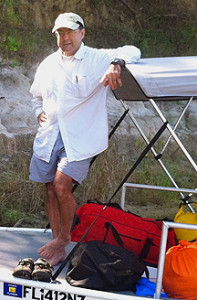
by Dan Tonsmeire
A vital piece of Florida’s economy and livelihoods are hinging on historic actions this year by the U.S. Army Corps of Engineers and the Supreme Court of the United States. It’s a continuation of the Florida-Georgia water war — one that’s been going on for decades. The trial is set for October 31st.
But this year matters more than any other. It’s not just because the Supreme Court and the Corps will set precedent over national policy that could provide clear guidance regarding longstanding and costly decisions between states (e.g., Delaware and Colorado River Basins). It’s not just because these decisions affect people, communities and governments across this country battling for fairness in water use, allocation, and management across state borders. But now, it’s at a time when we are more aware than ever of how precious and critical water and preserving the balance of our ecological world is to the future of all of us. The opportunity to change how we use and share water between competing interests for growing food, drinking, economic development within a context of maintaining the very ecosystems that sustain human life on a socially just and equitable basis is before us.
Apalachicola River and Bay is an internationally significant ecological resource that hosts the highest biodiversity of any river system in North America and one of the most productive estuaries in the northern hemisphere. Recognized for its unique and critical ecological role in the SE U.S., it now holds international, national and state designations aimed at protecting and maintaining its natural productivity, including Man in the Biosphere Reserve of the U.N.’s UNESCO Program, National Estuarine Research Reserve by NOAA and the U.S. Congress, and the State of Florida as an Outstanding Florida Water, Area of Critical State Concern, and Florida Aquatic Preserve. Two of the largest and most prominent International Conservation Organizations have also weighed in. The Nature Conservancy (TNC) has purchased thousands of acres along the banks of the Apalachicola River and shores of the Bay naming it 1 of 10 Biological Hotspots in the U.S. The Natural Resources Defense Council (NRDC) listed the Apalachicola and the surrounding area a BIOGEM, a list that includes such notable areas of the world as Yellowstone National Park, the Arctic National Wildlife Refuge, and the Patagonia Ecosystem in South America.
The freshwater flow from the Apalachicola-Chattahoochee-Flint (ACF) River Basin begins in the foothills of the Smokey Mountains in North Georgia, flows thru Atlanta and along the boundary between Georgia and Alabama, before the Chattahoochee and Flint Rivers join at the State line to flow thru the Apalachicola River Floodplain and into Apalachicola Bay.
Those freshwater flows bring nutrients fueling a biological factory that is the primary driver of the productivity of Apalachicola Bay and nourishes habitat over 250 miles out into the eastern Gulf of Mexico. In 2012 the Apalachicola Bay collapsed due to a lack of freshwater. Shrimp could not be found in the eastern Gulf, crab traps came up empty, skinny flounder were pulled in at record low numbers, and the world famous oyster industry of Apalachicola Bay was decimated.
The 2012 event was well-documented, but partisan politics and a rigid legal system have captured common sense and any ability to resolve the issues. The Corps says it can’t recognize the Bay needs and Georgia denies any responsibility despite the evidence that their use of the water consumes over 40% of the Apalachicola’s flow during droughts. We are experiencing periods of natural drought that hold the Apalachicola in deep drought for periods of time 2-3 times longer than ever before. But Georgia wants more than even its current over consumption and the Corps’ seems all too willing to hold more water back to accommodate them.
Now, four years later, the river and bay are just beginning a meager recovery. But unfortunately, the Corps has proposed revising its policies in its first Water Control Manual update since 1958 in a way that will create even more prolonged drought periods in the Apalachicola River and Bay. And this time, fishermen and scientists don’t think the river and bay are likely to recover from the next drought. Florida — and the whole country — stands to lose a lot more than just Apalachicola’s world-famous oysters.
Georgia and the Corps must change their course to prevent devastating economic loss in Florida. More than 54,000 jobs and $5.6 billion in sales revenues are realized in west Florida alone from the recreational fishing and seafood industry in the Eastern Gulf. Because of this, numerous national and statewide conservation organizations, the State of Florida, and federal agencies have requested that the Corps reconsider its methods and rewrite its proposed policies to place equal importance on the conservation of the fish and wildlife that support these jobs, livelihoods and a world renowned ecosystem. I am hoping these pleas haven’t fallen on deaf ears.
In D.C., Congress has been unable to break the logjam with a powerful Georgia delegation blocking legislation that would direct the Corps to equitably manage the water. Former presidential candidate Sen. Marco Rubio and Sen. Bill Nelson have expressed the gravitas of the Corps’ proposed policies. “The bottom line is that the status quo is only working for one state,” Rubio said on the Senate floor in April.
These two pending decisions are the last chance to reverse 60 years of water depletion, abandon polices that have dried up the Colorado River Delta, and put the Apalachicola and U.S. water policy on a track toward recovery. Continuing Georgia’s unfettered water use and Corps management that ignores impacts to the Bay will result in lost livelihoods and the demise of this last great bay in the Northern Hemisphere. Its loss will be felt all across the nation.
Dan Tonsmeire has served as the Apalachicola Riverkeeper since February 2004. He is committed to saving the Apalachicola River along with protecting and restoring the Apalachicola Bay, one of the last great estuaries left in America.


